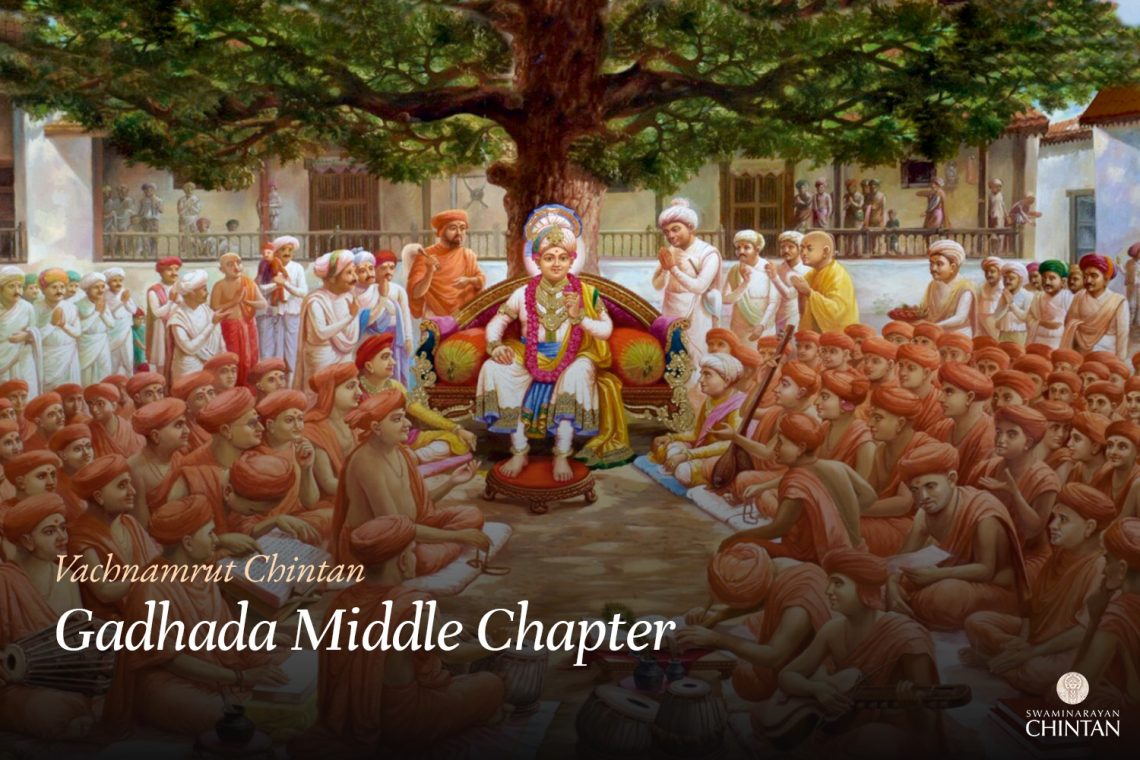Central Insights:
- Methods to maintain constant contemplation on God.
Key Points:
- Constant contemplation on God can be maintained through four methods: the mind’s tendency to attach, bravery, vairagya (non-attachment), and fear.
Explanation:
In this Vachanamrut, Shreeji Maharaj begins by inviting a question-and-answer session. At this time, Muktanand Swami asks, “What are the methods to maintain constant concentration on the form of God?” In response, Shreeji Maharaj explains that there are four types of methods: the mind’s tendency to attach, bravery, fear, and vairagya (non-attachment).
Regarding the mind’s tendency, Maharaj explains that the mind clings wherever it is focused. For example, just as it attaches to one’s children or spouse, it can similarly attach to God. A historical example is Meera Bai, whose mind, from a young age, became attached to the image of God through a certain event, leading her to declare, “Govind is my life, the world is bitter.” Similarly, in the Bhagavatam, the Gopis express that after experiencing the touch of God’s feet, the material world became poison to them. The history of the Satsang also contains many instances where just one divine event caused devotees to renounce worldly attachments entirely. Thus, for a person whose mind has the tendency to attach, if it gets attached to God, they can maintain constant contemplation on Him.
The second method is bravery. For a person with extreme bravery, if obstacles or distractions appear on the path to God, their brave heart generates strong thoughts and removes the obstacles or distractions. As a result, they can constantly focus on God. Bravery naturally removes untoward thoughts and interruptions. Examples of devotees like Dhruv, Bharthari, Raja Bhai Dangar, Surdas, and Tulsidas show how their bravery allowed them to remove obstacles and maintain constant contemplation on God.
The third method is fear. A person who lives in constant fear of the cycle of birth, death, hell, or the 84 lakh life forms will, through fear, keep their mind constantly on God. Fear has the effect of eliminating any action against God’s will. For instance, in the Bhagavatam, after being saved from the jaws of death, Ajamila maintained constant devotion to God out of fear of further consequences. A devotee who truly believes in the reality of birth and death is constantly reminded of God through this fear.
The fourth method is vairagya (non-attachment). A person who possesses vairagya uses the knowledge of the Sankhya Shastra to recognize the soul as distinct from the body. Understanding this, they can constantly meditate on God. Vairagya is the antidote to attachment to anything other than God, helping one to focus solely on God. The lives of our Nand saints and other great ascetic saints provide examples of this. Through these four methods, one can
attain unbroken meditation on God. Without these methods, one may attempt countless other ways, but unless God grants His grace, unbroken contemplation is not possible. Unbroken contemplation on God is a difficult task that only occurs when the virtuous deeds from countless past lives are ripe for fruition; otherwise, it is rare.
Maharaj has discussed the practice of constant contemplation in Vach.G.F. 49, where Brahmanand Swami asks about the method of akhanda vritti (constant contemplation). In that answer, Maharaj emphasizes the importance of inner vision and describes it as the path to akhanda vritti. In Vach.G.M.4, Maharaj speaks about the rarity of akhanda vritti and its associated methods. The faith required for constant remembrance of God is essential; if there is a flaw in one’s faith, then their understanding of God’s greatness is also diminished. When faith is lacking, so too is the conviction in God’s supreme glory. Therefore, when one possesses faith and awareness of God’s greatness, akhanda chintavan (constant contemplation) becomes possible. Maharaj also explains that this soul’s attachment to things other than God is maya. This attachment to the body, its relations, and the means of sustaining the body is stronger than even the attachment to the five senses. When one’s attachment to the body is severed, they have crossed maya. When this attachment is replaced by love for God, then akhanda vritti on God becomes possible. For one who achieves this state, no further spiritual practice remains.
Glossary
| Akhanda Vritti – Constant contemplation on God |
| Vairagya – Detachment From Everything Except God |
| Mind’s Tendency to Attach – Natural inclination of the mind to attach itself to something |
| Govind – A name of God, specifically referring to Krishna |
| Sankhya Shastra – Philosophical scripture that explains the distinction between the soul and body |
| Akhanda Chintavan – Constant remembrance of God |
| Maya – Illusion The material energy that entangles the Jeev in worldly existence and distracts from Bhagwan. |
| Faith in God’s Greatness – Complete belief in God’s supreme glory |
| Nine Forms of Devotion – Various practices to connect with God Shravanam (hearing), Kirtanam (chanting), Smaranam (remembering), Padasevanam (serving the God), Archanam (worship), Vandanam (salutation, bow down), Dasyam (servitude), Sakhyam (friendship), and Atmanivedanam (self-surrender) |

